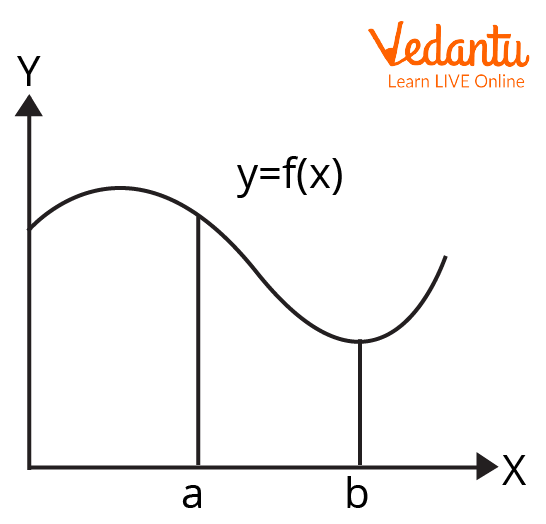




How to Use Newton Leibniz Theorem to Solve Calculus Problems
Newton Leibniz Theorem has a wide range of applications in calculus used to determine the definite integrals of a function whose limits are functions of any independent variable. In this article, we will be discussing the proof of the theorem in detail.

Integration of The Curve
History of Isaac Newton

Isaac Newton
Name: Isaac Newton
Born: 4 January 1643
Died: 31 March 1727
Field: Mathematics
Nationality: British
Statement of Newton Leibniz Theorem
$\dfrac{d}{d t}\left(\int_{a(t)}^{b(t)} f(x, t) d x\right)={\int_{a}^{b}\delta_{t}f(x, t) )dx} + f(b,t).\dfrac{db}{dt} - f(a,t).\dfrac{da}{dt}$
where $a(t)$ and $b(t)$ are definite limits of the integral.
Proof of Newton Leibniz Rule for Integration
$I =\int_{a(t)}^{b(t)} f(x, t) d x$
Taking derivative,
$\dfrac{dI}{d t}=\dfrac{d}{d t}\left(\int_{a(t)}^{b(t)} f(x, t) d x\right)$
Now,
$\dfrac{dI}{d x}=\mathop{\lim}\limits_{\delta {t} \rightarrow 0} \dfrac{\int_{a+\delta {a}}^{b+\delta {b}} f(x, t+\delta {t}) dx-\int_{a}^{b} f(x, t) d x}{\delta {t}}$
$\dfrac{dI}{d x}=\mathop{\lim}\limits_{\delta {t} \rightarrow 0} \dfrac{1}{\delta {t}}({\int_{a+\delta {a}}^{b+\delta {b}} f(x, t+\delta {t}) dx-\int_{a}^{b} f(x, t) d x})$
$\dfrac{dI}{d x}=\mathop{\lim}\limits_{\delta {t} \rightarrow 0} \dfrac{1}{\delta {t}}({\int_{a+\delta {a}}^{a}} f(x, t+\delta {t}) dx + {\int_{a}^{b} f(x, t+\delta {t}) dx} + {\int_{b}^{b+\delta {b}}} f(x, t+\delta {t}) dx -\int_{a}^{b} f(x, t) d x)$
$\dfrac{dI}{d x}=\mathop{\lim}\limits_{\delta {t} \rightarrow 0} \dfrac{1}{\delta {t}}(-{\int_{a}^{a+\delta {a}} }f(x, t+\delta {t}) dx + {\int_{a}^{b}( f(x, t+\delta {t}) - f(x, t) )dx }+ {\int_{b}^{b+\delta {b}} f(x, t+\delta {t}) dx})$
We know
$\int_{a}^{b} f(x) d x = F(b)-F(a)$
From the slope definition,
$F(b)-F(a) = F’(c)(b-a)$
$ {\int_{b}^{b+\delta {b}} f(x, t+\delta {t}) dx}=F(x,t+\delta {t})-F(x,t)=f(c,t)(b+\delta {b}-b)=\delta {b}.f(c,t)$
$\mathop{\lim}\limits_{h \rightarrow 0} f(c,t).\delta {b} \rightarrow f(b,t).\delta {b}$
Now solving expression,
$\dfrac{dI}{d x}=\mathop{\lim}\limits_{\delta {t} \rightarrow 0} \dfrac{1}{\delta {t}}( {\int_{a}^{b}( f(x, t+\delta {t}) - f(x, t) )dx + f(b,t).\delta {b} - f(a,t).\delta {a}})$
$\dfrac{dI}{d x}=\mathop{\lim}\limits_{\delta {t} \rightarrow 0}( {\int_{a}^{b}\dfrac{( f(x, t+\delta {t}) - f(x, t) )dx}{\delta {t}} + f(b,t).\dfrac{\delta {b}}{\delta {t}} - f(a,t).\dfrac{\delta {a}}{\delta {t}}})$
$\dfrac{dI}{d x}= {\int_{a}^{b}\delta_{t}f(x, t) )dx} + f(b,t).\dfrac{db}{dt} - f(a,t).\dfrac{da}{dt}$
Limitations of Newton Leibniz Theorem
Newton Leibniz Theorem can not be applied in the case of indefinite integral. It holds good only in the case of Definite Integral.
Newton Leibniz Theorem is used to find definite integrals; however, it does not use the basic properties of definite integrals.
Applications of Newton Leibniz Theorem
The theorem can be used to find the integration as well as differentiation. We can find the first order, second order, and even $n^{th}$ order derivative.
The Newton Leibniz Theorem is used to find the definite integral when limits are themselves functions of any independent variable.
Solved Examples
1. Find $\dfrac{d}{d x} \int_{1}^{x^{4}} \sec d t$.
Ans: Let $u=x^{4}$. Then,
$\dfrac{d}{d x} \int_{1}^{x^{4}} \sec t d t \\\Rightarrow \dfrac{d}{d x} \int_{1}^{u} \operatorname{sectdt} \\\Rightarrow \dfrac{d}{d u}\left(\int_{1}^{u} \operatorname{sect} d t\right. \\\Rightarrow \sec u \dfrac{d u}{d x} \\\Rightarrow \sec \left(x^{4}\right) \cdot 4 x^{3}$
2. Find the derivative of $F(x)=\int_{\pi / 2}^{x^{3}} \cos t d t$.
Ans: $F^{\prime}(x)=\dfrac{d F}{d u} \dfrac{d u}{d x}\\\Rightarrow\dfrac{d}{d u}\left[\int_{\pi / 2}^{u} \operatorname{costdt}\right] \dfrac{d u}{d x} \\\Rightarrow(\cos u)\left(3 x^{2}\right) \\\Rightarrow\left(\cos x^{3}\right)\left(3 x^{2}\right) \\\left.F(x)=\int_{\pi / 2}^{x^{3}} \operatorname{costdt}=\sin t\right \\\Rightarrow \sin x^{3}-\sin \dfrac{\pi}{2} \\\Rightarrow\left(\sin x^{3}\right)-1 \\ \Rightarrow F^{\prime}(x) = \left(\cos x^{3}\right)\left(3 x^{2}\right)$
3. Evaluate $\int_{-\infty}^{0} x e^{x} d x$.
Ans: $\int_{-\infty}^{0} x e^{x} d x=\mathop{\lim}\limits_{t \rightarrow-\infty} \int_{t}^{0} x e^{x} d x$
We integrate by parts with $u=x, d v=e^{x} d x$
$\text { so that } d u=d x, v=e^{x} $
$\int_{t}^{0} x e^{x} d x=\left.x e^{x}\right|_{t} ^{0}-\int_{t}^{0} e^{x} d x $
$\Rightarrow-t e^{t}-1+e^{t}$
We know that $e^{t} \rightarrow 0$
as $t \rightarrow-\infty$, and by l'Hopital's Rule, we have
$\mathop{\lim}\limits_{t \rightarrow-\infty} e^{t} $
$\Rightarrow \mathop{\lim}\limits_{t \rightarrow-\infty} \dfrac{t}{e^{-t}} $
$\Rightarrow \mathop{\lim}\limits_{t \rightarrow-\infty} \dfrac{t}{e^{-t}} $
Using l'Hopital's Rule,
$\Rightarrow \mathop{\lim}\limits_{t \rightarrow-\infty}\left(-e^{t}\right)=0 $
$\text { Therefore } \int_{-\infty}^{0} x e^{x} d x $
$\Rightarrow \mathop{\lim}\limits_{t \rightarrow-\infty}\left(-t e^{t}-1+e^{t}\right) $
$\Rightarrow-0-1+0=-1$
Important Formulas to Remember
Newton Leibniz Formula:
$\dfrac{d}{d t}\left(\int_{a(t)}^{b(t)} f(x, t) d x\right)={\int_{a}^{b}\delta_{t}f(x, t) )dx} + f(b,t).\dfrac{db}{dt} - f(a,t).\dfrac{da}{dt}$
Important Points to Remember
Newton Leibniz Theorem is applicable in the case of definite integrals.
It can be used to find differentiation as well as integration.
Conclusion
We have a different set of formulas in Calculus that are used to find the integral of functions. However, the normal formulas and their properties do not apply in the case of functions where limits are themselves functions, so we need Newton Leibniz Theorem. The theorem is a unique theorem in its character and sense and is very helpful in solving problems.
FAQs on Newton Leibniz Theorem: Definition, Formula & Applications
1. What is the Newton Leibniz principle?
The Newton Leibniz principle states that integration and differentiation are inverse processes. It connects the definite integral of a function with its antiderivative, making it key in calculus for solving problems involving the Newton Leibniz Theorem.
2. What is the Leibniz theorem?
Leibniz theorem provides a formula for the nth derivative of a product of two functions. It uses a sum involving binomial coefficients and derivatives, which is very useful in advanced calculus involving the Newton Leibniz Theorem.
3. Who first proved the fundamental theorem of calculus?
Isaac Newton and Gottfried Wilhelm Leibniz independently proved the fundamental theorem of calculus. Their combined work formed the basis of what we call the Newton Leibniz Theorem today.
4. What is the full Leibniz rule?
The full Leibniz rule gives a general formula for the derivative of a product of two functions: $$\frac{d^n}{dx^n}(fg) = \sum_{k=0}^n \binom{n}{k} f^{(k)}(x) g^{(n-k)}(x)$$. It is a key extension of the Newton Leibniz Theorem.
5. What is the main statement of the Newton Leibniz Theorem?
The Newton Leibniz Theorem states that if $F(x)$ is an antiderivative of $f(x)$, then $$\int_a^b f(x) dx = F(b) - F(a)$$. It directly links integration with differentiation.
6. Why is the Newton Leibniz Theorem important in calculus?
Newton Leibniz Theorem is important because it provides a simple way to compute definite integrals using antiderivatives, making many calculus problems easier to solve for students.
7. How does the Newton Leibniz Theorem help solve area problems?
The Newton Leibniz Theorem helps solve area problems by relating the area under a curve to the difference in values of an antiderivative. This practical approach simplifies calculations in integration.
8. Can the Newton Leibniz Theorem be used for all continuous functions?
Yes, the Newton Leibniz Theorem applies to all functions that are continuous on a closed interval, ensuring the definite integral equals the difference of the antiderivative at two points.
9. What are the conditions for applying the Newton Leibniz Theorem?
- The function $f(x)$ must be continuous on $[a, b]$.
- An antiderivative $F(x)$ must exist.























